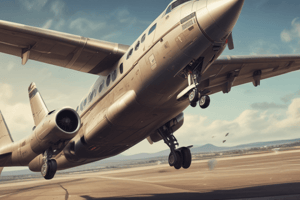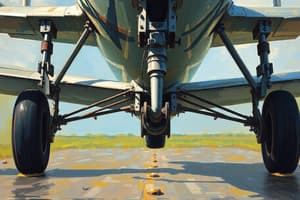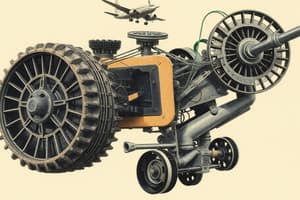Podcast
Questions and Answers
Which condition is NOT required for alternate braking to be active in flight?
Which condition is NOT required for alternate braking to be active in flight?
- G HYD pressure insufficient
- Antiskid N/W Switch ON
- Parking brake ON (correct)
- BLUE HYD pressure available
The initial brake force in alternate braking mode is lower than in normal mode.
The initial brake force in alternate braking mode is lower than in normal mode.
False (B)
What do pilots need to modulate brake pressure at or below to avoid wheel locking when antiskid is deactivated?
What do pilots need to modulate brake pressure at or below to avoid wheel locking when antiskid is deactivated?
1000 PSI
Accumulators are designed to supply ___ full brake applications.
Accumulators are designed to supply ___ full brake applications.
Match the following autobrake settings with their deceleration rates:
Match the following autobrake settings with their deceleration rates:
What happens if the green hydraulic pressure is lost during the use of the parking brake?
What happens if the green hydraulic pressure is lost during the use of the parking brake?
The MAX autobrake setting is typically used for takeoff.
The MAX autobrake setting is typically used for takeoff.
What must happen for automatic switching to alternate braking to be achieved?
What must happen for automatic switching to alternate braking to be achieved?
What is required for the autobrakes to activate in LO/MED mode?
What is required for the autobrakes to activate in LO/MED mode?
Autobrakes can activate below 72 knots due to ground spoilers not extending.
Autobrakes can activate below 72 knots due to ground spoilers not extending.
What is the primary purpose of the BSCU in the braking system?
What is the primary purpose of the BSCU in the braking system?
The ________ gear and main L/G deploy by gravity.
The ________ gear and main L/G deploy by gravity.
Match the following braking modes with their descriptions:
Match the following braking modes with their descriptions:
Which condition will NOT disarm the autobrakes?
Which condition will NOT disarm the autobrakes?
The anti-skid system remains operational even at low speeds.
The anti-skid system remains operational even at low speeds.
What happens when brake release orders are given in the anti-skid system?
What happens when brake release orders are given in the anti-skid system?
What mechanism reduces the main gear length during retraction?
What mechanism reduces the main gear length during retraction?
The nose landing gear retracts backwards toward the fuselage.
The nose landing gear retracts backwards toward the fuselage.
What is the primary purpose of the hydraulically operated pitch trimmer on each boogie?
What is the primary purpose of the hydraulically operated pitch trimmer on each boogie?
The landing gear position indicators are provided by __________.
The landing gear position indicators are provided by __________.
Under what conditions does the L/G selector lever lock in the 'Down' position?
Under what conditions does the L/G selector lever lock in the 'Down' position?
What happens to the main and nose landing gear during a gravity extension?
What happens to the main and nose landing gear during a gravity extension?
Match the following components with their functions:
Match the following components with their functions:
What is the primary role of the LGCIU during landing gear operation?
What is the primary role of the LGCIU during landing gear operation?
Flashcards
A330 Main Landing Gear
A330 Main Landing Gear
Consists of four wheels in a tandem arrangement, an oleopneumatic shock absorber, and anti-skid brakes. It has a shortening mechanism for retraction.
A330 Nose Landing Gear
A330 Nose Landing Gear
Features a two-wheel nose gear strut with an oleopneumatic steering system. It retracts forward into the fuselage.
Landing Gear Control
Landing Gear Control
Electrically controlled by LGCIU's; hydraulically actuated by the green hydraulic system, with safety valves above 280kts, and position indicators provided by LGCIU 1.
LG Gravity Extension
LG Gravity Extension
Signup and view all the flashcards
L/G Selector Lever (UP)
L/G Selector Lever (UP)
Signup and view all the flashcards
L/G Selector Lever (DOWN)
L/G Selector Lever (DOWN)
Signup and view all the flashcards
LGCIU
LGCIU
Signup and view all the flashcards
Landing Gear Safety Valves
Landing Gear Safety Valves
Signup and view all the flashcards
Alternate Braking (with Antiskid)
Alternate Braking (with Antiskid)
Signup and view all the flashcards
Alternate Braking (without Antiskid)
Alternate Braking (without Antiskid)
Signup and view all the flashcards
Accumulator Function
Accumulator Function
Signup and view all the flashcards
Parking Brake
Parking Brake
Signup and view all the flashcards
Auto Brake Panel (LO/DECEL ON)
Auto Brake Panel (LO/DECEL ON)
Signup and view all the flashcards
Autobrake MAX Setting
Autobrake MAX Setting
Signup and view all the flashcards
Autobrake MED/LO Setting
Autobrake MED/LO Setting
Signup and view all the flashcards
Slippery Runway and Deceleration
Slippery Runway and Deceleration
Signup and view all the flashcards
L/G Gravity Extension
L/G Gravity Extension
Signup and view all the flashcards
Normal Brakes
Normal Brakes
Signup and view all the flashcards
Alternate Brakes
Alternate Brakes
Signup and view all the flashcards
Autobrakes Arming Conditions
Autobrakes Arming Conditions
Signup and view all the flashcards
Autobrakes Activation
Autobrakes Activation
Signup and view all the flashcards
Autobrakes Deactivation
Autobrakes Deactivation
Signup and view all the flashcards
Antiskid Operation
Antiskid Operation
Signup and view all the flashcards
Antiskid Deactivation Speed
Antiskid Deactivation Speed
Signup and view all the flashcards
Normal Braking Conditions
Normal Braking Conditions
Signup and view all the flashcards
Normal Braking Activation
Normal Braking Activation
Signup and view all the flashcards
Dual Channel BSCU
Dual Channel BSCU
Signup and view all the flashcards
Study Notes
Landing Gear (A330)
- Main Landing Gear: Each main landing gear has four wheels, twin tandem boogie assembly, and oleopneumatic shock absorbers.
- Wheel Components: Each wheel has an anti-skid brake and is fitted with a mechanism.
- Main Gear Length Reduction: Hydraulically operated pitch trimmer on each boogie retracts the shock absorber into the main leg during retraction, reducing main gear length.
- Nose Landing Gear: Two nose wheel oleopneumatic strut steering system wheels retract forward to the fuselage.
L/G Operation
-
Gear and Door Sequencing: Gear and door sequencing is electrically controlled by the LGCIU's.
-
LGCIU Operation: Each LGCIU has switches; after one complete gear (or in each case of a failure, 4G) retraction, each completes a cycle.
-
Hydraulic Activation of Gears and Doors: All gears and doors are hydraulically activated by the green hydraulic system.
-
Safety Valves: Safety valves isolate the hydraulic supply.
-
Position Indicators: Landing gear position indicators on the center panel are provided by LGCIU 1 (even if LGCIU 2 is controlling the gear cycle.)
-
Speed Limit: Above 280kts
Gravity Extension
- Gravity Extension System: The gravity extension system is controlled through two selectors.
- Electro-Mechanical System: Electro-mechanical systems are located in the center instrument panel.
- Gear Door Operation: When the electrical L/G hydraulic system is isolated by the green selector, the main and nose landing gears, and doors, are extended by gravity. Locking springs assist in downlocking. During free fall operation, it's possible to restore normal hydraulic operation provided the green hydraulic pressure is available.
- Nose Landing Gear and Doors: Main and nose landing gears and doors remain open.
L/G Selector Lever
- Two-Position Selector: The two-position selector has electrical signals to 2 LGCIU.
- Up Position: Retraction of gear
- Down Position: Interlock mechanism prevents unsafe retraction of the lever. The position of the MLG and N/LG shock absorbers is crucial; when the lever is down, the wheel bogies are compressed, and the lever must be extended on the ground.
- Warning: A red arrow with ECAM warning in the approach, at 750 H RA, if the L/G are not down locked in landing configuration.
Gravity Extension (Continued)
- Actuators: Two motorized actuators close the hydraulic cut-off valve to close doors and disengage nose gear, which permits the main L/G to deploy automatically and lock-down.
General
- Braking System: Normal brakes use green hydraulics; alternate brakes use blue hydraulics.
- Channel and Controls: Dual channel BSCU controls all braking modes and functions. Normal, alternate, Autobrake, and Antiskid braking.
BSCU Channel Selection
- Changes at Each L/G Down Failure: Changes in the BSCU channel selection occur at each landing gear (L/G) down failure.
- Anti-skid system: Main L/G has fusible plugs, cooling fans, and anti-skid.
- Normal/Alternate Servo Valves and Auto Brake: Anti-skid brake servo valves, normal/alternate servo valves and auto brake system.
- Full Braking Performance: Performance is achieved only at full pedal deflection, and when without auto brake, the system shows released brakes.
- Antiskid System operation: Comparisons of speed, deceleration, and deceleration orders are essential during antiskid operation. If deceleration is less than 0.88, brake release orders are released.
Auto Brakes
- Arming Conditions: Auto-braking systems deploy when the green hydraulic pressure is electrically available and there's no failure in the braking system; at least 2 PRIMS are available with at least one Adiru.
- Autobrake Activation: The autobrakes activate at the command of the ground-based spoilers.
- Spolier Deployment: Spoiler deployment extends before the speed reaches 40kts
- Autobrake Deactivation: When the spoilers extend below 72kts, the autobrakes do not initiate.
- Autobrake Disarming: Autobrakes are disarmed via reversing the arming condition and releasing the parking brakes.
Auto Brakes (Continued)
- Parking Brakes: Repressing the brakes' arming condition, when the activation condition satisfies the autobrake deflection condition at one brake pedal, these autobrakes are active during take-off and touch-and-go.
Operation
- Normal Braking: Antiskid, auto-brakes, and green hydraulic pressure are required for normal braking.
- Alternate Braking: If green hydraulic pressure is insufficient and blue hydraulic pressure, with the antiskid switch on and the NW (nose wheel) and parking brake activated, then alternate braking is activated. If either antiskid or NW is not available, then alternate braking is not available.
- Parking Brake: Parking brakes are supplied by blue hydraulic system.
- Normal Braking and Brake Pedals: Brake application is via brake pedals.
- BSCU: BSCU automatically controls the alternate brake via the alternate servo valves.
- Pressure Indication: Brake and accumulator pressure is indicated on the triple indicator.
Auto Brake Panel
- Arming Procedure: Push buttons to deploy the ARM followed by LO/MED/MAX for takeoff deceleration.
- Deceleration Modes: Selected for takeoff, Landing, and Progressive Pressure Deployments are for deceleration and ALC.
- Deceleration Rate: when the autobrake is active correspond to the 80% of selected Rate (2.65m/s)
Automatic Switching
- Alternative Braking: Automatic switching to alternative braking via an auto hydraulic selector controlled by BSCU and control via alternate servo valves.
- Pressure Indication: Brake and accumulator pressure is indicated on the triple indicator during the mode.
- Alternative Braking: Alternative braking operates without antiskid when antiskid and autobrakes are inoperative.
- Antiskid Deactivation: Electricity (A/SKID N/W ST SW off or Power supply failure or BSCU failure) or low pressure in hydraulic system (B+G), disrupts the antiskid system and activates alternative braking by using only the brake accumulator pressure.
- Pilot Module Operation: Pilot must modulate the brake pressure at take off or landing to prevent wheel locking.
Parking Brake
- Alternative Braking for Parking: Parking brake may initiate alternative braking via blue hydraulic while the antiskid system is not available.
- A/SKID/N/W STRO: (A/SKID/N/W STRO) activates the available system if GREEN HYD is available.
- Parking Brake Activation: Green HYD pressure lost; alternative braking commences; brake application is via brake pedals, and the antiskid/nose wheel is no longer available.
- No Parking Brake: If the system does not detect that the Blue hydraulics with the antiskid is operational, then no parking brake is functional.
Studying That Suits You
Use AI to generate personalized quizzes and flashcards to suit your learning preferences.



